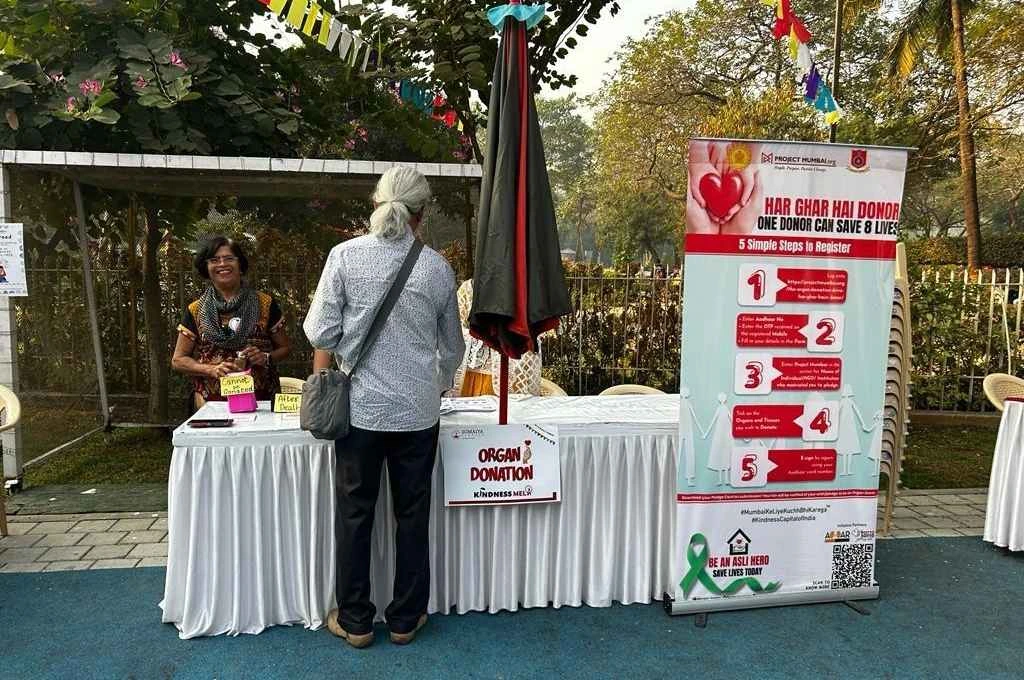The lifeblood of any skilling programme is its frontline staff—fieldworkers, community mobilisers, and trainers.
This is no different for the Skill Impact Bond, which works with a range of on-ground skilling partners to equip 50,000 young Indians, 60 percent of whom are women, with the skills needed for gainful employment. This photo essay gives a glimpse into the day-to-day lives of the frontline staff who support young trainees at every step of the way—from mobilisation to training to employment.
Phase 1: Community mobilisation
Mobilisation is the process of identifying and engaging the right candidates to enrol in skill training programmes.

Nirmala, a community mobiliser from Magic Bus, goes door-to-door in Patancheru basti, Hyderabad, distributing flyers and speaking to families. She informs them about the programme and provides clear answers to the questions that parents of potential candidates ask, such as: “What kind of jobs can you help my child get? What kind of salary is offered?”, “How far away is the training and job location? Will she need to travel at odd hours?”, and “What about her safety?”
Nirmala builds rapport with parents by answering all their questions. She also encourages them to visit the training centre for a quick tour.
Before beginning mobilisation, Nirmala and her team carefully mapped every job opportunity and employer in the area and pre-empted the concerns that would arise.

Community mobilisers also facilitate conversations between programme alumni and community members. In rural Jharkhand, Dinesh* and Arun*, two young men currently enrolled in employment training with PanIIT Alumni Foundation, join their trainer at a mobilisation camp in a village.
They speak directly to their community about the nature of the training programme being offered to others from their village, share their experience with it, and inform the community about possible job opportunities.
Engaging alumni from the community is an effective method of building trust and credibility in the programme, as they share first-hand accounts of working conditions and assuage any concerns and misconceptions around it.

Mina* and Rani*, two young women from Khunti, Jharkhand, attended the camp and want to know more about the training programme. They ask the trainer, “Can we even get admitted if we haven’t finished school? Will this help us find jobs?” and “Where will we stay for the duration of the training?”
The trainer answers all their questions, addressing their fears and concerns. He explains that the training centre in Jharkhand has several young women from their area, many of whom are enrolling in male-dominated sectors such as automotive and electronics.

Phase 2: Skill training
Before the programme begins, training partners meet with each student and their family to understand their motivations, concerns around skilling and employment, and future aspirations. They also explain what the programme offers, what the training journey will look like, and the kind of opportunities that could open up after completion. These conversations help build trust and align expectations from the outset.

Family buy-in plays a key role in reducing dropouts during the training. At a skill training centre in Hyderabad, Sunkery, a trainer from Magic Bus, hosts a parents meet.
For all trades, training partners also conduct a ‘week-zero’ orientation that allows candidates to preview the training programme’s structure and intensity for one week without committing to enrolment. This gives trainees the flexibility to switch to a more suitable option and training partners the chance to optimise resources by reducing dropouts later in the training.

Basanti* is training with PanIIT to become a smartphone assembly technician. Training partners work with employers to challenge gender norms, highlight women’s skills, and redesign work environments to foster greater inclusion. When technical roles such as automobile engineering and electrical manufacturing are opened up for women, they gain access to a wider range of opportunities, which often leads to higher salaries and career growth.

Training has helped Leela*, a candidate from Magic Bus, gain confidence to participate in group discussions. For many candidates, transitioning from education to employment is a significant challenge. Building workplace readiness, including soft skills, is crucial for improving employability, and is highly valued by prospective workplaces. These skills also enable youth to develop stronger relationships and networks, supporting their growth and success.

Sangeeta, a trainer at a PanIIT residential gurukul, demonstrates a board with various electrical engineering components to young women, helping them become familiar with new terms. Trainers are instrumental to the success of skilling programmes and forge long-lasting relationships with trainees to support a smooth transition to the world of work.

Trainers also encourage young trainees to build community and peer groups focused on supporting one another, during training and beyond. These peer support groups are a critical feature of successful training programmes.
Phase 3: Employment
Support from trainers does not end once candidates are placed in jobs and transition out of the employment programme. Training partners have dedicated retention staff who ensure that young people remain in the workforce, that their workplaces are safe and positive, and that they grow in their careers.
Some trainers even accompany trainees post-placement to their job sites if they are leaving their home states, helping them ease into the new environment during the early days. In some cases, retention staff also collaborate with employers to provide culturally familiar amenities, such as regional food, to help trainees adjust. They also assist trainees in opening bank accounts and provide financial literacy training on salary management and savings.

Retention staff also serve as a bridge between trainees and employers, offering immediate support and guidance. Open channels of communication are established, allowing trainees to voice their concerns and ensuring prompt action and resolution of any workplace challenges.
For employers hiring women for the first time, retention staff make certain that working conditions are safe and hygienic, and that work processes and protocols are adapted for female workers. In addition, they sensitise male staff to working alongside women to promote a safe and comfortable environment.

Earning an income enables women to become decision-makers and choose how to spend their money, whether it’s buying a phone, sending savings home, supporting siblings’ education, ensuring better nutrition, or saving for further education.
Through the programme and beyond, frontline staff, community mobilisers, trainers, and placement staff work to ensure that the young people secure, stay, and grow in jobs, thereby bridging the gap between skilling and employment.
*Names changed to maintain confidentiality.
The authors would like to acknowledge Learnet Skills Limited, Magic Bus India Foundation, and PanIIT Alumni Foundation for facilitating the documentation of these photographs and stories. All photos are owned under copyright by the British Asian Trust.
—







